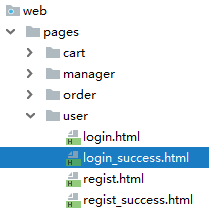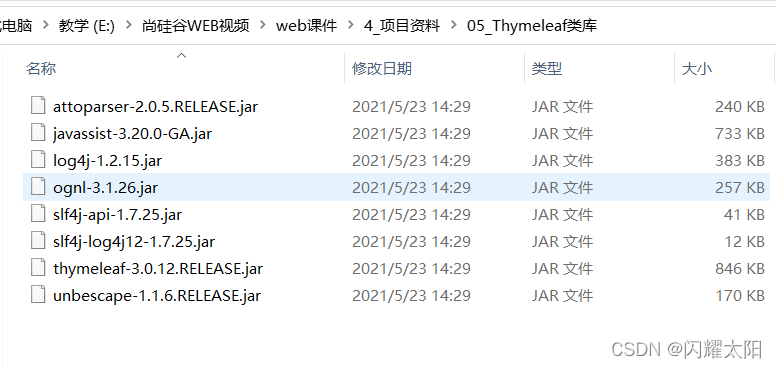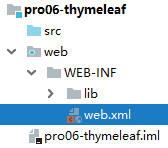1 Thymeleaf
1.1 Thymeleaf的概念
Thymeleaf是一款用于渲染XML/XHTML/HTML5内容的模板引擎。类似JSP,Velocity,FreeMaker等, 它也可以轻易的与Spring MVC等Web框架进行集成作为Web应用的模板引擎。它的主要作用是在静态页面上渲染显示动态数据
1.2 Thymeleaf的优势
- SpringBoot官方推荐使用的视图模板技术,和SpringBoot完美整合。
- 不经过服务器运算仍然可以直接查看原始值,对前端工程师更友好。
<!DOCTYPE html>
<html lang="en" xmlns:th="http://www.thymeleaf.org">
<head>
<meta charset="UTF-8">
<title>Title</title>
</head>
<body>
<p th:text="${username}">Original Value</p>
</body>
</html>
1.3 物理视图和逻辑视图
1.3.1 物理视图
在Servlet中,将请求转发到一个HTML页面文件时,使用的完整的转发路径就是物理视图

如果我们把所有的HTML页面都放在某个统一的目录下,那么转发地址就会呈现出明显的规律:
/pages/user/login.html
/pages/user/login_success.html
/pages/user/regist.html
/pages/user/regist_success.html……
路径的开头都是:/pages/user/
路径的结尾都是:.html
所以,路径开头的部分我们称之为视图前缀 路径结尾的部分我们称之为视图后缀
1.3.2 逻辑视图
物理视图=视图前缀+逻辑视图+视图后缀
上面的例子中:
| 视图前缀 | 逻辑视图 | 视图后缀 | 物理视图 |
|---|---|---|---|
| /pages/user/ | login | .html | /pages/user/login.html |
| /pages/user/ | login_success | .html | /pages/user/login_success.html |
1.4 Thymeleaf 入门案例
1.4.1 导入jar包

1.4.2 配置上下文参数

物理视图=视图前缀+逻辑视图+视图后缀
<!-- 在上下文参数中配置视图前缀和视图后缀 -->
<context-param>
<param-name>view-prefix</param-name>
<param-value>/WEB-INF/view/</param-value>
</context-param>
<context-param>
<param-name>view-suffix</param-name>
<param-value>.html</param-value>
</context-param>
说明:param-value中设置的前缀、后缀的值不是必须叫这个名字,可以根据实际情况和需求进行修改。
为什么要放在WEB-INF目录下?
原因:WEB-INF目录不允许浏览器直接访问,所以我们的视图模板文件放在这个目录下,是一种保护。以免外界可以随意访问视图模板文件。
访问WEB-INF目录下的页面,都必须通过Servlet转发过来,简单说就是:不经过Servlet访问不了。
这样就方便我们在Servlet中检查当前用户是否有权限访问。
那放在WEB-INF目录下之后,重定向进不去怎么办?
重定向到Servlet,再通过Servlet转发到WEB-INF下。
1.4.3 创建Servlet基类
这个类大家直接复制粘贴即可,将来使用框架后,这些代码都将被取代。
import org.thymeleaf.TemplateEngine;
import org.thymeleaf.context.WebContext;
import org.thymeleaf.templatemode.TemplateMode;
import org.thymeleaf.templateresolver.ServletContextTemplateResolver;
import javax.servlet.ServletContext;
import javax.servlet.ServletException;
import javax.servlet.http.HttpServlet;
import javax.servlet.http.HttpServletRequest;
import javax.servlet.http.HttpServletResponse;
import java.io.IOException;
public class ViewBaseServlet extends HttpServlet {
private TemplateEngine templateEngine;
@Override
public void init() throws ServletException {
// 1.获取ServletContext对象
ServletContext servletContext = this.getServletContext();
// 2.创建Thymeleaf解析器对象
ServletContextTemplateResolver templateResolver = new ServletContextTemplateResolver(servletContext);
// 3.给解析器对象设置参数
// ①HTML是默认模式,明确设置是为了代码更容易理解
templateResolver.setTemplateMode(TemplateMode.HTML);
// ②设置前缀
String viewPrefix = servletContext.getInitParameter("view-prefix");
templateResolver.setPrefix(viewPrefix);
// ③设置后缀
String viewSuffix = servletContext.getInitParameter("view-suffix");
templateResolver.setSuffix(viewSuffix);
// ④设置缓存过期时间(毫秒)
templateResolver.setCacheTTLMs(60000L);
// ⑤设置是否缓存
templateResolver.setCacheable(true);
// ⑥设置服务器端编码方式
templateResolver.setCharacterEncoding("utf-8");
// 4.创建模板引擎对象
templateEngine = new TemplateEngine();
// 5.给模板引擎对象设置模板解析器
templateEngine.setTemplateResolver(templateResolver);
}
protected void processTemplate(String templateName, HttpServletRequest req, HttpServletResponse resp) throws IOException {
// 1.设置响应体内容类型和字符集
resp.setContentType("text/html;charset=UTF-8");
// 2.创建WebContext对象
WebContext webContext = new WebContext(req, resp, getServletContext());
// 3.处理模板数据
templateEngine.process(templateName, webContext, resp.getWriter());
}
}
1.4.4 创建index.html 页面
<!DOCTYPE html>
<html lang="en">
<head>
<meta charset="UTF-8">
<title>系统首页</title>
<base href="http://localhost:8090/07_thymeleaf/">
</head>
<body>
<a href="helloServlet">跳转到hello.html页面</a>
</body>
</html>
1.4.5 创建HelloServlet
- 编辑Servlet
package com.auguigu.servlet;
import javax.servlet.ServletException;
import javax.servlet.http.HttpServletRequest;
import javax.servlet.http.HttpServletResponse;
import java.io.IOException;
public class HelloServlet extends ViewBaseServlet{
@Override
protected void doGet(HttpServletRequest request, HttpServletResponse response) throws ServletException, IOException {
doPost(request,response);
}
@Override
protected void doPost(HttpServletRequest request, HttpServletResponse response) throws ServletException, IOException {
System.out.println("已经访问了Serlvet了");
request.setAttribute("msg","我是服务器数据!!!!!!!!");
this.processTemplate("hello",request,response);
}
}
- 编辑web.xml配置
<servlet>
<servlet-name>HelloServlet</servlet-name>
<servlet-class>com.auguigu.servlet.HelloServlet</servlet-class>
</servlet>
<servlet-mapping>
<servlet-name>HelloServlet</servlet-name>
<url-pattern>/helloServlet</url-pattern>
</servlet-mapping>
1.4.6 编辑Thymeleaf页面
<!DOCTYPE html>
<html lang="en" xmlns:th="http://www.thymeleaf.org">
<head>
<meta charset="UTF-8">
<title>这是一个欢迎页面</title>
</head>
<body>
<h1 th:text="${msg}"></h1>
</body>
</html>
1.5 Thymeleaf基本语法
1.5.1 th名称空间

1.5.2 th:text 作用
代码示例:
<p th:text="标签体新值">标签体原始值</p>
- 不经过服务器解析,直接用浏览器打开HTML文件,看到的是『标签体原始值』
- 经过服务器解析,Thymeleaf引擎根据th:text属性指定的『标签体新值』去替换『标签体原始值』
1.5.3 修改指定属性值
代码示例:
<input type="text" name="username" th:value="文本框新值" value="文本框旧值" />
语法:任何HTML标签原有的属性,前面加上『th:』就都可以通过Thymeleaf来设定新值。
1.5.4 解析URL地址
代码示例:
<!--
使用Thymeleaf解析url地址
-->
<a th:href="@{/index.html}">访问index.html</a>
经过解析后得到:
/webday08/index.html
所以@{}的作用是在字符串前附加『上下文路径』
这个语法的好处是:实际开发过程中,项目在不同环境部署时,Web应用的名字有可能发生变化。所以上下文路径不能写死。而通过@{}动态获取上下文路径后,不管怎么变都不怕啦!
1.5.5 关于index.html访问说明
- 为什么在index.html 使用th标签失效

- 原理说明

如果我们直接访问index.html本身,那么index.html是不需要通过Servlet,当然也不经过模板引擎,所以index.html上的Thymeleaf的任何表达式都不会被解析。
解决办法:通过Servlet访问index.html,这样就可以让模板引擎渲染页面了:

进一步的好处:
通过上面的例子我们看到,所有和业务功能相关的请求都能够确保它们通过Servlet来处理,这样就方便我们统一对这些请求进行特定规则的限定。
- 完成IndexServlet
public class IndexServlet extends ViewBaseServlet {
@Override
protected void doGet(HttpServletRequest request, HttpServletResponse response) throws ServletException, IOException {
doPost(request,response);
}
@Override
protected void doPost(HttpServletRequest request, HttpServletResponse response) throws ServletException, IOException {
//跳转到index.html页面中
System.out.println("这里是idnexServlet的位置");
request.setAttribute("msg","欢迎页面信息");
this.processTemplate("index",request,response);
}
}
- 配置servlet路径
<servlet>
<servlet-name>IndexServlet</servlet-name>
<servlet-class>com.auguigu.servlet.IndexServlet</servlet-class>
</servlet>
<servlet-mapping>
<servlet-name>IndexServlet</servlet-name>
<url-pattern>/index.html</url-pattern>
</servlet-mapping>
1.6 关于域的说明
1.6.1 请求域(Request域)
在请求转发的场景下,我们可以借助HttpServletRequest对象内部给我们提供的存储空间,帮助我们携带数据,把数据发送给转发的目标资源。
请求域:HttpServletRequest对象内部给我们提供的存储空间
总结: 在同一个请求中实现数据共享

1.6.2 会话域(Session域)
说明: 在同一个会话下,可以发起多个交互, 在同一个会话下实现数据共享.

1.6.3 应用域(Application域)
说明: 在同一个tocmat服务器中实现数据共享

1.6.4 Thymeleaf中操作域对象
我们通常的做法是,在Servlet中将数据存储到域对象中,而在使用了Thymeleaf的前端页面中取出域对象中的数据并展示
- 编辑Servlet将数据保存到与对象中
@Override
protected void doPost(HttpServletRequest request, HttpServletResponse response) throws ServletException, IOException {
//1.向request域中添加数据
request.setAttribute("requestMsg","request域中的数据");
//2.向Session域中添加数据
request.getSession().setAttribute("sessionMsg","Session域中的数据");
//3.向Application域中添加数据
request.getServletContext().setAttribute("contextMsg","ConText域中的数据");
this.processTemplate("value",request,response);
}
- 从域中获取数据
<!--1.从request域中获取数据-->
<h1 th:text="${requestMsg}"></h1>
<!--2.从Session域中获取数据-->
<h1 th:text="${session.sessionMsg}"></h1>
<!--3.从Application域中获取数据-->
<h1 th:text="${application.contextMsg}"></h1>

1.7 获取请求参数
1.7.1 获取请求参数的语法
${param.参数名}
1.7.2 页面效果展现
- 编辑页面
<!--thymeleaf参数获取测试 -->
<a href="paramServlet?id=1&name=tomcat">参数取值操作</a>
- 页面参数获取
<h1>获取参数信息</h1>
<p th:text="${param.id}"></p>
<p th:text="${param.name}"></p>
1.7.3 同名参数提交说明
- 编辑页面
<!--thymeleaf参数获取测试 -->
<a href="paramServlet?id=1&name=tomcat&hobby=java&hobby=mysql&hobby=js">参数取值操作</a>
- 页面取值
<!--获取同名参数 获取数组,按照数组类型输出 -->
<p th:text="${param.hobby}"></p>
<p th:text="${param.hobby[0]}"></p>
<p th:text="${param.hobby[1]}"></p>
<p th:text="${param.hobby[2]}"></p>

1.8 内置对象
1.8.1 内置对象的概念
所谓内置对象其实就是在Thymeleaf的表达式中可以直接使用的对象
1.8.2 基本内置对象

用法举例:
<h3>表达式的基本内置对象</h3>
<p th:text="${#request.getContextPath()}">调用#request对象的getContextPath()方法</p>
<p th:text="${#request.getAttribute('helloRequestAttr')}">调用#request对象的getAttribute()方法,读取属性域</p>
基本思路:
- 如果不清楚这个对象有哪些方法可以使用,那么就通过getClass().getName()获取全类名,再回到Java环境查看这个对象有哪些方法
- 内置对象的方法可以直接调用
- 调用方法时需要传参的也可以直接传入参数
1.8.3 公共内置对象

Servlet中将List集合数据存入请求域:
request.setAttribute("aNotEmptyList", Arrays.asList("aaa","bbb","ccc"));
request.setAttribute("anEmptyList", new ArrayList<>());
页面代码:
<p>#list对象isEmpty方法判断集合整体是否为空aNotEmptyList:<span th:text="${#lists.isEmpty(aNotEmptyList)}">测试#lists</span></p>
<p>#list对象isEmpty方法判断集合整体是否为空anEmptyList:<span th:text="${#lists.isEmpty(anEmptyList)}">测试#lists</span></p>
1.9 OGNL表达式
1.9.1 OGNL的概念
OGNL:Object-Graph Navigation Language对象-图 导航语言
1.9.2 对象图的概念
从根对象触发,通过特定的语法,逐层访问对象的各种属性。

1.9.3 OGNL语法
① 起点
在Thymeleaf环境下,${}中的表达式可以从下列元素开始:
- 访问属性域的起点
- 请求域属性名
- session
- application
- param
- 内置对象
- request
- session
- lists
- strings
② 属性访问语法
- 访问对象属性:使用getXxx()、setXxx()方法定义的属性
- 对象.属性名
- 访问List集合或数组
- 集合或数组[下标]
- 访问Map集合
- Map集合.key
- Map集合[‘key’]
1.10 分支与迭代
1.10.1 if和unless
让标记了th:if、th:unless的标签根据条件决定是否显示。
语法说明:
当th:if判断为真时,显示标签体的内容. 否则不显示, 与unless的恰好相反.
if配合not关键词和unless配合原表达式效果是一样的,看自己的喜好。
- 编辑Servlet
@Override
protected void doPost(HttpServletRequest request, HttpServletResponse response) throws ServletException, IOException {
request.setAttribute("num",1);
this.processTemplate("ifOrFor",request,response);
}
- 编辑页面html
<!DOCTYPE html>
<html lang="en" xmlns:th="http://www.thymeleaf.org">
<head>
<meta charset="UTF-8">
<title>分支语法</title>
</head>
<body>
<h1>分支语法结构</h1>
<!--当判断结果为真时 显示标签体内容-->
<p th:text="${num}">num为100</p>
<p th:if="${num > 5}">num为100 >5</p>
<p th:if="${not(num > 5)}">num > 5 not</p>
<p th:unless="${num > 5}"> num > 5 unless</p>
</body>
</html>
1.10.2 switch
语法:
- th:switch
- th:case
@Override
protected void doPost(HttpServletRequest request, HttpServletResponse response) throws ServletException, IOException {
request.setAttribute("num",1);
request.setAttribute("level",3);
this.processTemplate("ifOrFor",request,response);
}
123456
<h3>switch分支语法</h3>
<div th:switch="${level}">
<p th:case="1">一级</p>
<p th:case="2">二级</p>
<p th:case="3">三级</p>
</div>
1.10.3 迭代用法
语法:
<tr th:each="teacher,status : ${teacherList}">
<td th:text="${status.count}">这里显示编号</td>
<td th:text="${teacher.teacherName}">这里显示老师的名字</td>
</tr>
在迭代过程中,可以参考下面的说明使用迭代状态:

<!--遍历显示请求域中的teacherList-->
<table border="1" cellspacing="0" width="500">
<tr>
<th>编号</th>
<th>姓名</th>
</tr>
<tbody th:if="${#lists.isEmpty(teacherList)}">
<tr>
<td colspan="2">教师的集合是空的!!!</td>
</tr>
</tbody>
<!--
集合不为空,遍历展示数据
-->
<tbody th:unless="${#lists.isEmpty(teacherList)}">
<!--
使用th:each遍历
用法:
1. th:each写在什么标签上? 每次遍历出来一条数据就要添加一个什么标签,那么th:each就写在这个标签上
2. th:each的语法 th:each="遍历出来的数据,数据的状态 : 要遍历的数据"
3. status表示遍历的状态,它包含如下属性:
index 遍历出来的每一个元素的下标
count 遍历出来的每一个元素的计数
-->
<tr th:each="teacher,status : ${teacherList}">
<td th:text="${status.count}">这里显示编号</td>
<td th:text="${teacher.teacherName}">这里显示老师的名字</td>
</tr>
</tbody>
</table>
1.11 Thymeleaf包含其他模板文件
1.11.1 应用场景
说明: 由于头部标签每个页面都会使用,如果重复编辑则耦合性高,则需要将页面信息进行抽取,之后统一进行引用.

1.11.2 编辑头部页面
<!DOCTYPE html>
<html lang="en" xmlns:th="http://www.thymeleaf.org">
<head>
<meta charset="UTF-8">
<title>头部</title>
</head>
<body>
<div th:fragment="jd_head">
我是京东页面头部
</div>
</body>
</html>
1.11.2 编辑页面
| 语法 | 效果 | 特点 |
|---|---|---|
| th:insert | 把目标的代码片段整个插入到当前标签内部 | 它会保留页面自身的标签 |
| th:replace | 用目标的代码替换当前标签 | 它不会保留页面自身的标签 |
| th:include | 把目标的代码片段去除最外层标签,然后再插入到当前标签内部 | 它会去掉片段外层标记,同时保留页面自身标记 |
页面代码举例:
<!-- 代码片段所在页面的逻辑视图 :: 代码片段的名称 -->
<div id="badBoy" th:insert="segment :: header">
div标签的原始内容
</div>
<div id="worseBoy" th:replace="segment :: header">
div标签的原始内容
</div>
<div id="worstBoy" th:include="segment :: header">
div标签的原始内容
</div>
1.12 综合项目练习
1.12.1 完成列表展现
- 初始化页面

2.列表展现页面

1.12.2 用户新增页面
说明: 点击提交按钮时,完成数据提交,并且重定向到列表页面

1.12.3 用户修改操作
说明: 当点击修改按钮时,实现数据回显, 默认密码不显示,如果赋值默认修改.

1.12.4 完成用户删除操作
提示: 根据ID删除数据 可以实现数据的动态传递. 具体代码参数文档资料
<td>
<a th:href="@{/toUpdateUser(id=${user.id})}"><button>编辑</button></a>
<a th:href="@{/deleteUserById(id=${user.id})}"><button>删除</button></a>
</td>
本文由 liyunfei 创作,采用 知识共享署名4.0
国际许可协议进行许可
本站文章除注明转载/出处外,均为本站原创或翻译,转载前请务必署名
最后编辑时间为: Jul 26,2022